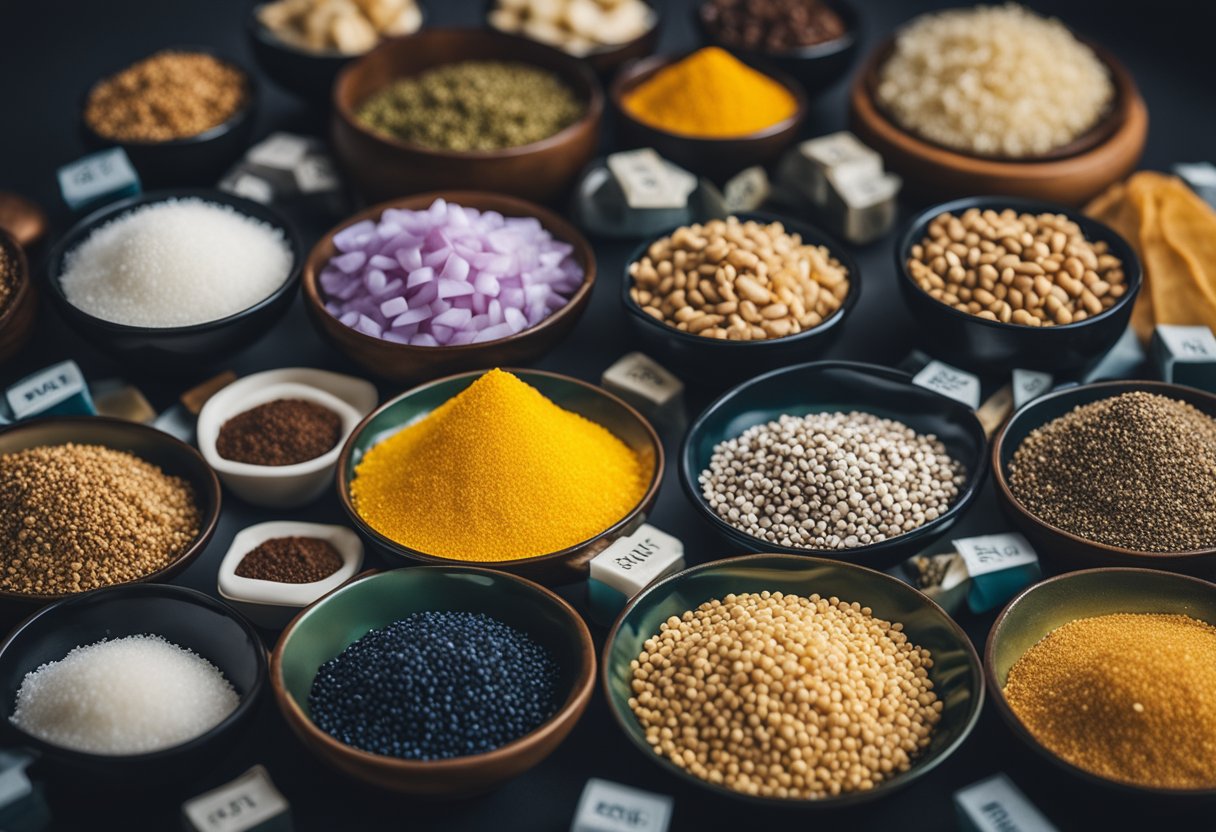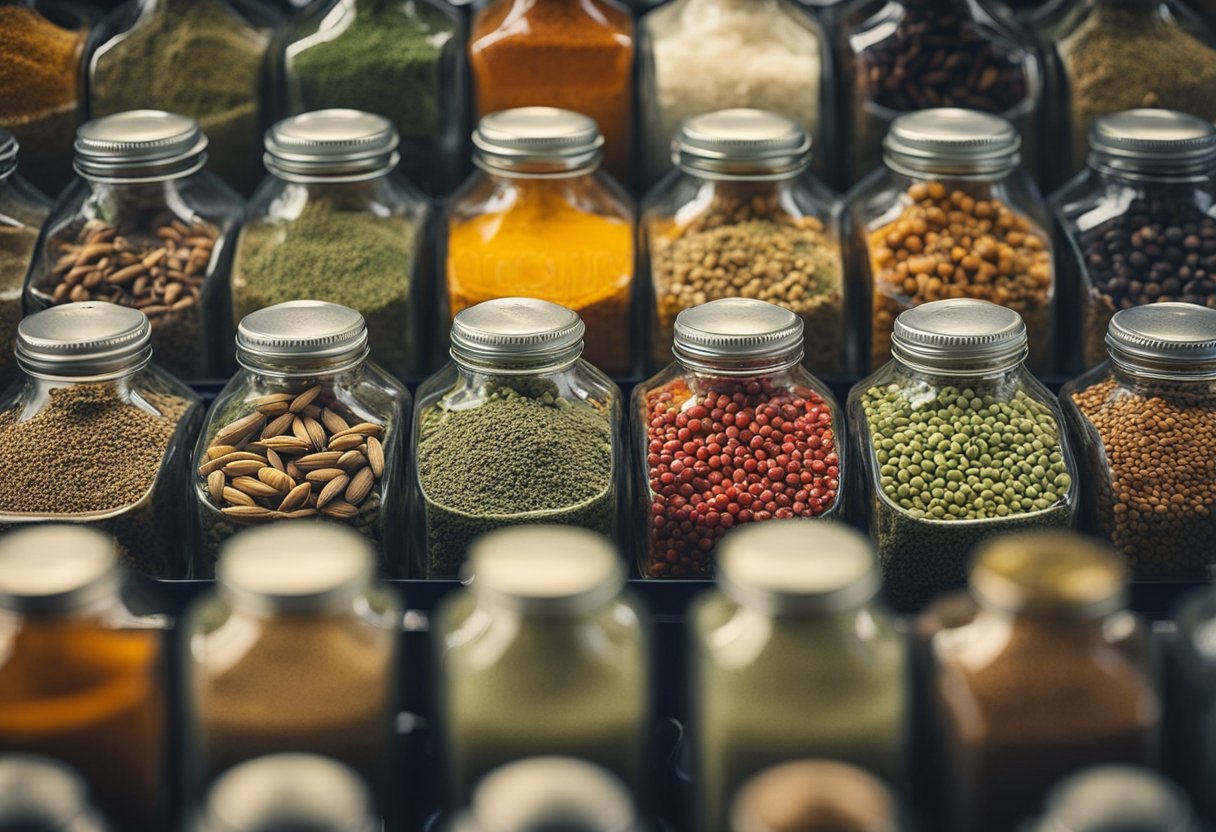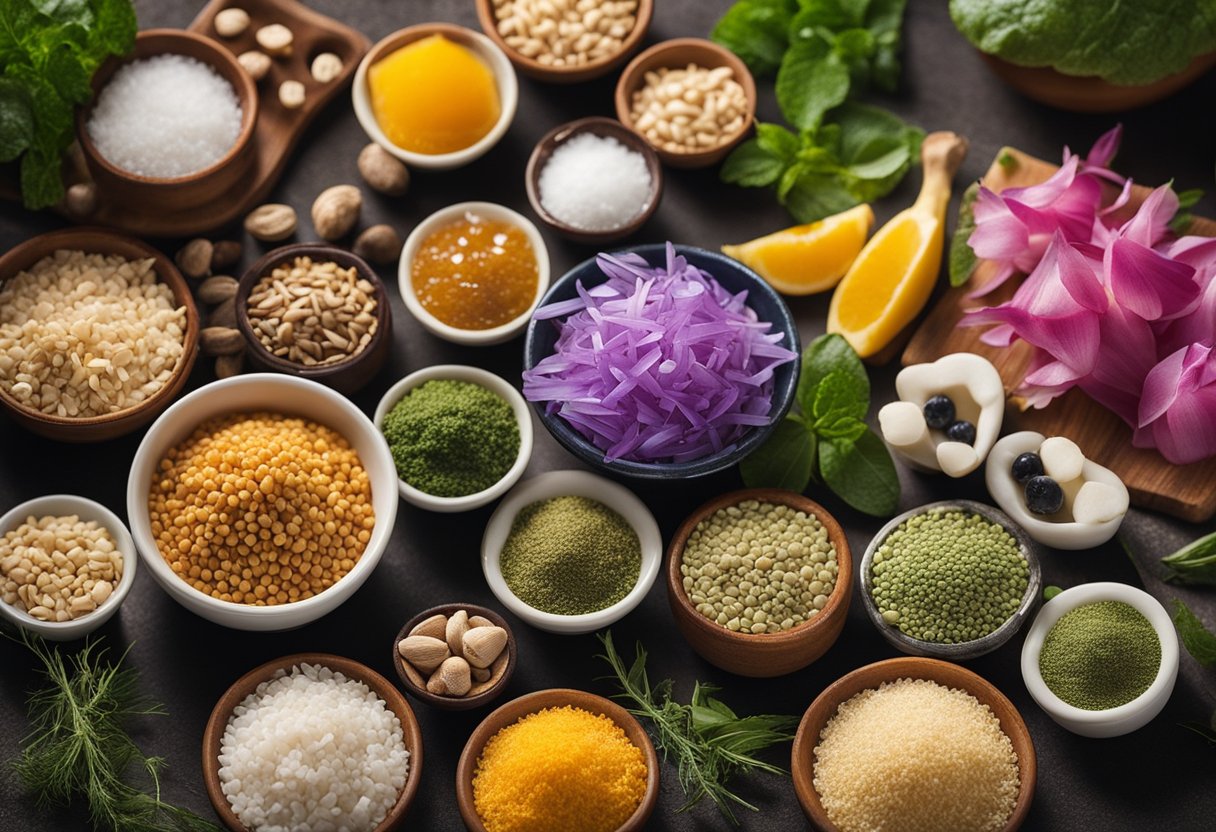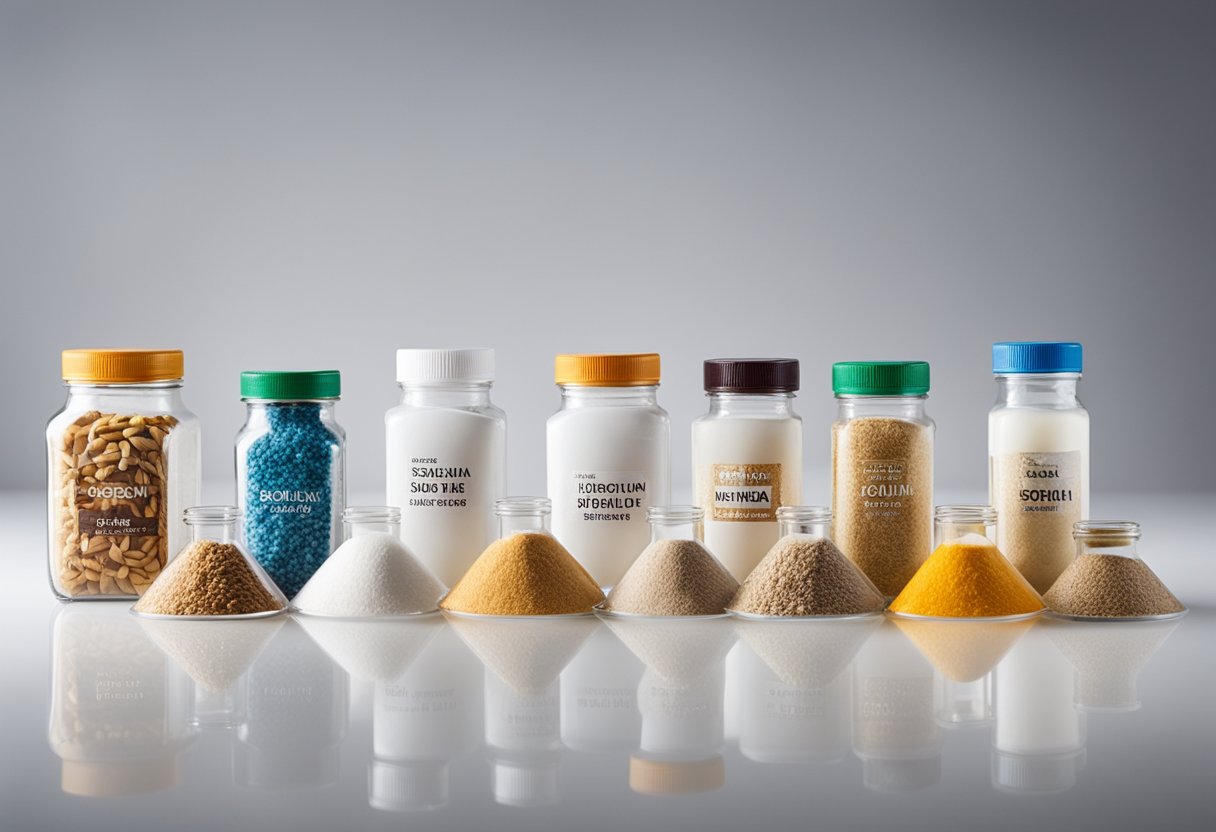As a food lover, I know how important it is to have the right balance of flavors in a dish. One of the most commonly used flavor enhancers is MSG or Monosodium Glutamate.
However, there are concerns about the health effects of consuming MSG, and some people may be sensitive to it. That’s where MSG substitutes come in.

MSG substitutes are ingredients that can be used in place of MSG to add flavor to a dish. These substitutes can be natural or synthetic, and they come in a variety of forms.
Some of the most commonly used substitutes include salt, beef stock, soy sauce, and tomato paste. By using these substitutes, you can achieve a similar flavor profile without the potential health risks associated with MSG.
Key Takeaways:
- MSG substitutes can be used to add flavor to a dish without the potential health risks associated with MSG.
- Some of the most commonly used substitutes include salt, beef stock, soy sauce, and tomato paste.
- By using these substitutes, you can achieve a similar flavor profile to MSG.
Understanding MSG

As a food additive, MSG, or Monosodium Glutamate, is a flavor enhancer that is widely used in many cuisines around the world.
MSG is a white crystalline powder that is made up of glutamate and sodium ions. It has a savory, umami taste that can enhance the flavor of food and make it more delicious.
Despite its widespread use, MSG remains a controversial ingredient. Some people claim that it causes headaches, nausea, and other health problems.
However, the FDA has classified MSG as a safe food additive, and numerous studies have failed to find any conclusive evidence that it is harmful to human health.
MSG is typically added to savory foods such as soups, stews, and sauces, as well as snacks like chips and crackers. It is also used in many Asian cuisines, where it is often added to dishes such as stir-fries, noodles, and sushi.
While MSG is a popular flavor enhancer, there are many MSG substitutes available for those who prefer to avoid it.
These substitutes can help to add flavor and depth to dishes without the use of MSG. Some of the most popular MSG substitutes include salt, soy sauce, beef stock, and flavored oils.
Overall, while MSG remains a controversial ingredient, it is generally considered safe by regulatory agencies and many chefs and food manufacturers continue to use it as a flavor enhancer.
However, for those who prefer to avoid it, there are many safe and delicious MSG substitutes available.
Health Concerns with MSG
As a flavor enhancer, MSG has been a popular ingredient in many processed foods. However, there have been concerns about its impact on health, particularly in terms of blood pressure and hypertension.
Studies have shown that MSG can cause an increase in blood pressure in some individuals, which can lead to hypertension. This is a concern, as hypertension can increase the risk of heart disease and stroke.
Additionally, some people may be allergic to MSG, which can cause symptoms such as headache, flushing, sweating, and chest pain. While these symptoms are generally mild and go away on their own, they can be uncomfortable.
It’s important to note that the FDA considers MSG safe for consumption, and there is no conclusive evidence that it causes long-term health problems.
However, if you are concerned about your intake of MSG, there are alternative flavor enhancers that you can use in your cooking.
For example, herbs such as garlic, savory, tarragon, rosemary, and pepper can add a savory flavor to your dishes.
Spices like turmeric and cumin can also add warmth and depth to your meals. By using these natural flavor enhancers, you can avoid the potential health risks associated with MSG.
The Role of MSG in Cooking

As a professional chef, I am always looking for ways to enhance the flavor of my dishes. One ingredient that has been used for decades to achieve this is monosodium glutamate (MSG).
MSG is a flavor enhancer that is commonly used in Asian cuisine, but it is also found in many processed foods, seasonings, and snacks.
MSG has a unique flavor profile that is often described as “umami.” Umami is one of the five basic tastes, along with sweet, sour, salty, and bitter.
It is a savory taste that is often associated with meaty or brothy flavors. MSG can enhance the umami flavor of a dish, making it taste richer and more satisfying.
In addition to enhancing flavor, MSG also has practical benefits in cooking. It can be used to reduce the amount of salt or fat needed in a recipe, making it a healthier option.
MSG is also a cost-effective ingredient that can help restaurants and chefs create more affordable meal options without sacrificing flavor.
Despite its benefits, MSG has been a controversial ingredient in recent years. Some people claim that it can cause headaches, nausea, and other adverse reactions.
However, the scientific evidence on this is mixed, and the FDA considers MSG to be safe for consumption.
As a chef, I believe that MSG can be a useful tool in the kitchen when used in moderation. However, it is important to be mindful of its potential effects and to use it responsibly.
By using MSG in combination with other ingredients and cooking techniques, chefs can create delicious and satisfying dishes that are sure to impress.
MSG in Different Cuisines

I have noticed that MSG is a common seasoning in many kitchens worldwide, especially in Asian cuisine. MSG is widely used in Chinese cooking and Japanese cooking, as well as in other Asian cuisines.
It is also used in some Western dishes, such as soups, stews, and gravies.
In Chinese cuisine, MSG is often added to dishes to enhance their flavor. It is used in stir-fries, soups, marinades, and sauces.
MSG is also added to meat dishes, such as pork and beef, to make them more tender and flavorful.
Japanese cooking also makes use of MSG in many dishes. It is often added to soups, broths, and sauces to give them a rich umami flavor. MSG is also used in sushi, tempura, and other Japanese dishes.
In other Asian cuisines, such as Korean and Vietnamese, MSG is also a common seasoning. It is used in soups, stews, and sauces to enhance their flavor. MSG is also used in some Indian and Middle Eastern dishes.
While MSG is widely used in many cuisines, some people are sensitive to it and may experience headaches, nausea, and other symptoms.
For this reason, many people are looking for MSG substitutes that can be used in their cooking without compromising flavor.
There are many alternatives to MSG that can be used in cooking. Some of the most popular substitutes include salt, soy sauce, beef stock, and Parmesan cheese.
These ingredients can be used to enhance the flavor of dishes without the need for MSG.
Overall, MSG is a common seasoning in many cuisines, particularly in Asian cooking. While it can enhance the flavor of dishes, it is important to be aware of its potential side effects.
By using MSG substitutes, such as salt and soy sauce, it is possible to create flavorful dishes without the need for MSG.
Natural MSG Sources

As a writer, I always try to find natural alternatives to artificial ingredients. When it comes to MSG, there are many natural sources that can be used to enhance the flavor of your dishes. Here are some of the most common natural sources of MSG:
- Cheese: Parmesan cheese is a rich source of natural MSG. It is produced through the fermentation process, which breaks down the proteins and releases amino acids.
- Beef Stock: Beef stock is another great source of natural MSG. It has a high level of glutamate and a meaty flavor that can enhance the umami flavor of your dish.
- Mushrooms: Shiitake mushrooms are a great source of natural MSG. They have a meaty flavor and are often used in Asian cuisine to enhance the flavor of soups, stews, and stir-fries.
- Seaweed: Dulse and kelp are two types of seaweed that are rich in natural MSG. They are often used in Japanese cuisine to add flavor to soups and salads.
- Soy Sauce: Soy sauce is a fermented product that contains natural MSG. It is often used in Asian cuisine to enhance the flavor of stir-fries, marinades, and dipping sauces.
- Anchovies: Anchovies are a rich source of natural MSG. They are often used in Mediterranean cuisine to add flavor to pasta dishes, pizzas, and salads.
- Oyster Sauce: Oyster sauce is a popular ingredient in Chinese cuisine. It is made from oysters, soy sauce, and other seasonings, and is a rich source of natural MSG.
- Sesame Oil: Sesame oil is a flavorful oil that is often used in Asian cuisine. It contains natural MSG and can be used to enhance the flavor of stir-fries, marinades, and dressings.
- Vegetables: Some vegetables, such as tomatoes and mushrooms, are naturally high in glutamate, which is the amino acid that gives MSG its flavor-enhancing properties.
- Soybeans: Soybeans are a rich source of glutamate, which is the amino acid that gives MSG its flavor-enhancing properties. Soy products, such as tofu and tempeh, are also high in glutamate.
Overall, there are many natural sources of MSG that can be used to enhance the flavor of your dishes.
By using these natural alternatives, you can avoid the potential health risks associated with consuming large amounts of artificial MSG.
MSG Substitutes in Cooking
When it comes to cooking, MSG is often used to enhance the flavor of dishes. However, some people may be sensitive to MSG or prefer not to use it in their cooking.
Fortunately, there are many MSG substitutes available that can provide similar flavor-enhancing effects.
One of the most common MSG substitutes is salt. Salt can be used to bring out the savory, umami notes in a dish, similar to how MSG is used.
However, it’s important to be mindful of the amount of salt used, as excessive sodium intake can lead to health problems.
Another option for an MSG substitute is a salt substitute. These products are designed to mimic the taste of salt but with lower sodium content. Some popular salt substitutes include potassium chloride and herb mixes.
Sauces and spices can also be used as MSG substitutes. For example, soy sauce and Worcestershire sauce can add a savory flavor to dishes, while herbs like thyme and rosemary can provide a similar umami taste.
Flavored oils, such as avocado oil and sunflower oil, can also be used as MSG substitutes. These oils can add a rich, savory flavor to dishes without the need for MSG.
In addition to these options, there are also naturally occurring glutamates, such as those found in mushrooms and tomatoes, that can enhance the flavor of dishes. Amino acids and acids, such as vinegar, can also provide similar effects.
Overall, there are many MSG substitutes available that can provide similar flavor-enhancing effects in cooking. By experimenting with different options, you can find the best substitutes for your preferred dishes.
MSG Substitutes in Specific Dishes

As someone who loves to cook, I understand the importance of finding the right flavors for specific dishes. MSG is a common ingredient in many recipes, but it’s not always the best option.
Luckily, there are plenty of MSG substitutes that can be used in specific dishes to achieve the same delicious taste.
Soups and Stews
When it comes to soups and stews, I like to use beef or chicken broth as an MSG substitute. The broth adds a rich, savory flavor that enhances the taste of the soup.
If you’re looking for a vegetarian option, you can use vegetable broth instead. Another great option is miso paste, which adds a salty, umami flavor to the soup.
Pasta and Pizza
For pasta and pizza dishes, I like to use Parmesan cheese as an MSG substitute. The cheese has a naturally occurring glutamate that adds a delicious savory flavor to the dish.
Another option is nutritional yeast, which has a cheesy, nutty flavor and can be used as a vegan alternative to Parmesan cheese.
Fish
When cooking fish, I like to use lemon juice as an MSG substitute. The acidity of the lemon juice adds a bright, fresh flavor to the fish. Another great option is white wine, which adds a subtle sweetness and acidity to the dish.
Bread
For bread recipes, I like to use herbs and spices as an MSG substitute. Rosemary, thyme, and oregano all add a savory flavor to bread.
Garlic and onion powder are also great options. Another option is to use a combination of salt and sugar, which enhances the flavor of the bread.
Casseroles and Risotto
When making casseroles and risotto, I like to use sautéed mushrooms as an MSG substitute. The mushrooms have a rich, meaty flavor that adds depth to the dish.
Another option is to use tomato paste, which adds a sweet, umami flavor to the dish.
Ramen and Bento Boxes
For ramen and bento boxes, I like to use soy sauce as an MSG substitute. The sauce adds a salty, umami flavor to the dish.
Another option is to use fish sauce, which has a similar flavor profile to soy sauce. Both sauces are great options for adding flavor to Asian-inspired dishes.
Overall, there are plenty of MSG substitutes that can be used in specific dishes to achieve the same delicious taste. By experimenting with different ingredients, you can find the perfect substitute for your favorite recipes.
Recipes Using MSG Substitutes
As someone who enjoys cooking healthy meals, I have found that using MSG substitutes is a great way to enhance the flavor of my dishes without compromising on health. Here are some recipes that I have tried and loved:
Beef Bone Broth
Beef bone broth is a great source of collagen and other nutrients that are good for your body. To make it, simply simmer beef bones with water and vegetables for several hours.
To enhance the flavor, I add a few dashes of fish sauce and a teaspoon of mushroom seasoning instead of MSG.
Fermented Seasoning
Fermentation is a great way to add flavor to your dishes without using MSG. To make a simple fermented seasoning, mix together equal parts of kosher salt and sugar and rub it onto a piece of kelp.
Place the kelp in a jar with some water and let it sit for a few days. The resulting liquid can be used to season soups, stews, and other dishes.
Worcestershire Sauce
Worcestershire sauce is a classic seasoning that can be used in a variety of dishes, from marinades to cocktails.
To make a homemade version, mix together vinegar, molasses, soy sauce, tamarind paste, and a few other ingredients. The resulting sauce is a great substitute for MSG in recipes that call for a savory, umami flavor.
Dashi
Dashi is a traditional Japanese broth that is made by simmering kombu (dried kelp) and bonito (dried fish flakes) in water.
To make a vegetarian version, simply omit the bonito flakes and use shiitake mushrooms instead. The resulting broth is a great substitute for MSG in recipes that call for a savory, umami flavor.
Processed Meat Alternatives
Processed meats are often loaded with MSG, but there are plenty of alternatives that are just as flavorful. For example, you can use smoked paprika instead of bacon in vegetarian dishes, or use tempeh or tofu instead of sausage in pasta dishes.
Overall, there are plenty of healthy and delicious alternatives to MSG that can be used in a variety of recipes. By experimenting with different seasonings and ingredients, you can enhance the flavor of your dishes without compromising on health.
Understanding Sodium Content in Substitutes

When it comes to reducing sodium intake, many people turn to salt substitutes like MSG or sea salt. However, it is important to understand the sodium content of these substitutes to make an informed decision.
Firstly, let’s talk about sodium. Sodium is an essential nutrient that our body needs to function properly. However, consuming too much sodium can lead to high blood pressure, which can increase the risk of heart disease and stroke.
Salt is the most common source of sodium in our diets, but there are other sources as well.
For example, MSG (monosodium glutamate) is a sodium salt of glutamic acid that is commonly used as a flavor enhancer in processed foods.
While MSG has been shown to be a useful partial substitute for salt, it still contains sodium.
Sea salt is another popular salt substitute. While it is often marketed as a healthier alternative to table salt, it still contains sodium. In fact, sea salt can sometimes contain even more sodium than table salt.
When choosing a salt substitute, it is important to check the sodium content. Some salt substitutes may contain less sodium than others.
For example, MSG contains two-thirds less sodium than table salt, making it a good option for those looking to reduce their sodium intake.
However, it is important to note that some people may be sensitive to MSG and experience symptoms like headaches or nausea.
In summary, while salt substitutes like MSG or sea salt can be useful in reducing sodium intake, it is important to understand their sodium content and choose wisely.
Checking the sodium content and understanding any potential sensitivities can help make an informed decision.
MSG Substitutes in Processed Foods

As a food additive, MSG is commonly used in processed foods to enhance the flavor. However, due to concerns over its potential health risks, many consumers are seeking alternatives to MSG.
As a food writer, I have researched and tested various MSG substitutes that can be used in processed foods.
One popular substitute for MSG is natural flavors. Natural flavors are derived from plant or animal sources and can be used to enhance the flavor of processed foods.
These flavors are often used in conjunction with other ingredients such as wheat and aromatics to create a complex flavor profile.
Another common substitute for MSG is bouillon cubes. Bouillon cubes are made from dehydrated vegetables, meat, and spices and can be used to add flavor to soups, stews, and other processed foods.
They are a convenient and affordable alternative to MSG and can be found in most grocery stores.
Wheat is also a popular substitute for MSG in processed foods. Wheat contains glutamic acid, which is similar in structure to MSG and can enhance the flavor of processed foods.
Aromatics such as garlic and onion can also be used to add flavor to processed foods without the use of MSG.
It is important to note that while these substitutes can be used in processed foods, they may not provide the same level of flavor enhancement as MSG.
It may be necessary to use a combination of substitutes to achieve the desired flavor profile.
In conclusion, as a food writer, I have found that there are several substitutes for MSG that can be used in processed foods. Natural flavors, bouillon cubes, wheat, and aromatics can all be used to enhance the flavor of processed foods without the use of MSG.
However, it is important to keep in mind that these substitutes may not provide the same level of flavor enhancement as MSG.
Frequently Asked Questions
What are some common alternative names for MSG?
MSG can also be listed on ingredient labels as monopotassium glutamate, glutamic acid, glutamate, yeast extract, hydrolyzed vegetable protein, autolyzed yeast, sodium caseinate, and calcium caseinate.
What are some healthy substitutes for Ajinomoto?
Ajinomoto is a brand name for a type of MSG. Some healthy substitutes for Ajinomoto include soy sauce, fish sauce, tomato paste, and nutritional yeast.
What can be used as a substitute for Aromat powder?
Aromat powder is a type of seasoning that contains MSG. Some substitutes for Aromat powder include garlic powder, onion powder, smoked paprika, and dried herbs like thyme or rosemary.
Is it possible to omit MSG from a recipe?
Yes, it is possible to omit MSG from a recipe. However, it may affect the overall flavor of the dish. To compensate for the missing umami flavor, you can add ingredients like mushrooms, miso paste, or Worcestershire sauce.
Can MSG be replaced with salt?
While salt can enhance the savory flavor of a dish, it cannot replace the unique umami flavor that MSG provides.
However, using salt in combination with other umami-rich ingredients like soy sauce or fish sauce can help to create a similar flavor profile.
What are some side effects of consuming MSG?
Some people may experience side effects after consuming MSG, such as headaches, nausea, and flushing. However, these side effects are rare and usually occur in large amounts.
MSG is generally recognized as safe by the FDA when consumed in moderate amounts.







